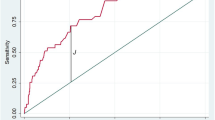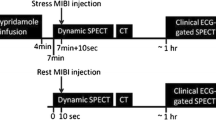Abstract
Background
Older women frequently undergo dipyridamole perfusion imaging and can have advanced coronary artery disease, but little data exist on the accuracy of perfusion imaging in detecting disease in individual vascular territories and multivessel disease in women, compared with men.
Methods and Results
From a database of patients undergoing myocardial single photon emission computed tomography (SPECT) perfusion imaging, 107 unselected sequential patients (58 women, 49 men) who underwent sestamibi dipyridamole stress and cardiac catheterization within 6 months of each other were identified. Data were analyzed to compare sensitivities for detection of individual coronary stenoses and multivessel disease.
The concordance between perfusion image results and cardiac catheterization for individual coronary territories for women was 75%, and for men, it was 65% (P=.09). In women, the presence of disease of the left anterior descending coronary artery was detected more frequently than it was in men, 84% versus 44% (P=.004). The detection of disease in the territories of the left circumflex and right coronary arteries was similar for both groups. For women, the accuracy of perfusion imaging in identifying the presence/absence of multivessel coronary disease was 64%, compared with 71% for men (P=not significant).
Conclusions
The accuracy of dipyridamole sestamibi SPECT imaging in detecting multivessel disease was similar for men and women. The sensitivity of dipyridamole sestamibi SPECT imaging in detecting disease of the left anterior descending artery was better in women.
Similar content being viewed by others
References
O'Keefe JH, Barnhart CS, Bateman TM. Comparison of stress echocardiography and stress my ocardial perfusion scintigraphy for diagnosing coronary artery disease and assessing its severity. Am J Cardiol 1995;75:1–11D.
Bonow RO. Diagnosis and risk stratification in coronary artery disease: Nuclear cardiology versus stress echocardiography. J Nucl Cardiol 1997;4:S172–8.
Wackers FJT. Diagnostic pitfalls of myocardial perfusion imaging in women. J Myocardial Ischemia 1992;10:23–31.
Hansen CL, Crabbe D, Rubin S. Lower diagnostic accuracy of thallium-201 SPECT myocardial perfusion imaging in women: An effect of smaller chamber size. J Am Coll Cardiol 1996;28:1214–9.
Amanullah AM, Kiat H, Friedman JD, Berman DS. Adenosine technetium-99m sestamibi myocardial perfusion SPECT in women: Diagnostic efficacy in detection of coronary artery disease. J Am Coll Cardiol 1996;27:803–9.
Taillefer R, DePuey EG, Udelson JE, Beller GA, Latour Y, Reeves F. Comparative dignostic accuracy of Tl-201 and Tc-99m sestamibi SPECT imaging (perfusion and ECG-Gated SPECT) in detecting coronary artery disese in women. J Am Coll Cardiol 1997;29:69–77.
Hachamovitch R, Berman DS, Kiat H, et al. Effective risk stratification using exercise myocardial perfusion SPECT in women: Gender related differences in prognostic nuclear testing. J Am coll Cardiol 1996;28:43–44.
Laurer MS, Pashkow FJ, Snader CE, Harvey SA, Thomas JD, Marwick TH. Gender and referral for coronary angiography after treadmill thallium testing. Am J Cardiol 1996;78:278–83.
Travin MI, Duca MD, Kline GM, Herman SD, Demus DD, Heller GV. Relation of gender to physician use of test results and to the prognostic value of stress technetium-99m sestamibi myocardial single-photon emission computed tomography scintigraphy. Am Heart J 1997;134:73–82.
Lerner DJ, Kannel WB. Pattems of coronary heart disease morbidity and mortality in the sexes. A 26-year follow-up of the Framingham population. Am Heart J 1986;111:383–90.
Leppo JA. Dipyridamole-thallium imaging: the lazy man's stress test. J Nucl Med 1989;30:281–7.
Diamond GA, Forrester JS. Analysis of probability as an aid in the clinical diagnosis of coronary-artery disease. N Engl J Med 1979;3000:1350–8.
Chambers CE, Brown KA. Dipyridamole-induced ST segment depression during thallium-201 imaging in patients with coronary artery disease: Angiographic and hemodynamic determinants. J Am Coll Cardiol 1988;12:37–41.
Schmoliner R, Dudezak R, Dronik G. et al. Thallium-201 imaging after dipyridamole in patients with coronary multivessel disease. Cardiology 1983;70:145–51.
Lewis JF, Lin L, McGorray S, Pepine CJ, Doyle M, Edmundowicz D, et al. Dobutamine stress echocardiography in women with chest pain. J Am Coll Cardiol 1999;33:1462–8.
Rozanski A, Diamond GA, Berman D, Forrester JS, Morris D, Swan HJC. The declining specificity of radionuclide ventriculography. N Engl J Med 1983;309:518–22.
Nygaard TW, Gibson RS, Ryan JM, Gascho JA, Watson DD, Beller GA. Prevalence of high-risk thallium-201 scintigraphic findings in left main coronary artery stenosis: Comparisn with patients with multiple- and single-vessel coronary artery disease. Am J Cardiol 1984;53:462–9.
Dash H, Massie BM, Botvinick EH, Brundage BH. The noninvasive identification of left main and three-vessel coronary artery disease by myocardial stress perfusion scintigraphy and treadmil exercise electrocardiography Circulation 1979;60:276–84.
Christian TF, Miller TD, Bailey KR, Gibbons RJ. Noninvasive identification of severe coronary artery disease using exercise tomographic thallium-201 imaging. Am J Cardiol 1992;70:14–20.
Mazzanti M, Germano G, Kiat H, Kavanagh PB, Alexanderson E, Freidman JD, et al. Identification of severe and extensive coronary artery disease by automatic measurement of transient ischemic dilation of the left ventricle in dual-isotope myocardial perfusion SPECT. J Am Coll Cardiol 1996;27:1612–20.
Williams KA, Schneider CM. Increased stress right ventricular activity on dual isotope perfusion SPECT. A sign of multivessel and/or left main coronary artery disease. J Am Coll Cardiol 1999;34:420–7.
Iskandrian AS, Heo J, Lemlek J, Ogilby JD, Untereker WJ, Iskandrian B, et al. Identification of high-risk patients with left main and three-vessel coronary artery disease by adenosine-single photon emission computed tomographic thallium imaging. Am Heart J 1993;125:1130–5.
Maddahi J, Abdulla A, Garcia EV, Swan HJ, Berman DS. Noninvasive indentification of left main and triple vessel coronary artery disease: Improved accuracy using quantitative analysis of regional myocardial stress distribution and washout of thallium-201. J Am Coll Cardiol 1986;7:53–60.
Tartagni F, Dondi M, Limonetti P, et al. Dipyridamole technetium-99m-methoxy isobutyl isonitrile tomoscintigraphic imaging for identifying diseased coronary vessels: Comparison with thallium-201 rest study. J Nucl Med 1991;32:369–76.
Nishimura S, Mahmarian JJ, Boyce TM, Verani MS. Quantitative thallium-201 emission computed tomography during maximal pharmacologic coronary vasodilatation with adenosine for assessing coronary artery disease. J Am Coll Cardiol 1991;18:736–45.
Miller DD, Younis LT, Chaitman BR, Stratmann H. Diagnostic accuracy of dipyridamole technetium-99m labeled sestamibi myocardial tomography for detection of coronary artery disease. J Nucl Cardiol 1997;4:18–24.
Tamaki N, Yonekura Y, Mukai T, et al. Stress thallium-201 transaxial emission computed tomography: Quantitative versus qualitative analysis for evaluation of coronary artery disease. J Am Coll Cardiol 1984;4:1213–21.
Van Train K, Berman DS, Garcia EV, et al. Quantitative analysis of stress thallium-201 myocardial scintigrams: A multic ente trial. J Nucl Med 1986;27:17–25.
Mahmarian JJ, Boyce TM, Goldberg RK, Cocanougher MK, Roberts R, Verani MS. Quantitative exercise thallium-201 single photon emission computed tomography for the enhanced diagnosis of ischemic heart disease. J Am Coll Cardiol 1990;15:318–29.
Watson DD. Quantitative SPECT techniques. Semin Nucl Med 1999;XXIX:192–203.
Author information
Authors and Affiliations
Rights and permissions
About this article
Cite this article
Travin, M.I., Katz, M.S., Moulton, A.W. et al. Accuracy of dipyridamole SPECT imaging in identifying individual coronary stenoses and multivessel disease in women versus men. J Nucl Cardiol 7, 213–220 (2000). https://doi.org/10.1016/S1071-3581(00)70009-2
Received:
Accepted:
Issue Date:
DOI: https://doi.org/10.1016/S1071-3581(00)70009-2




